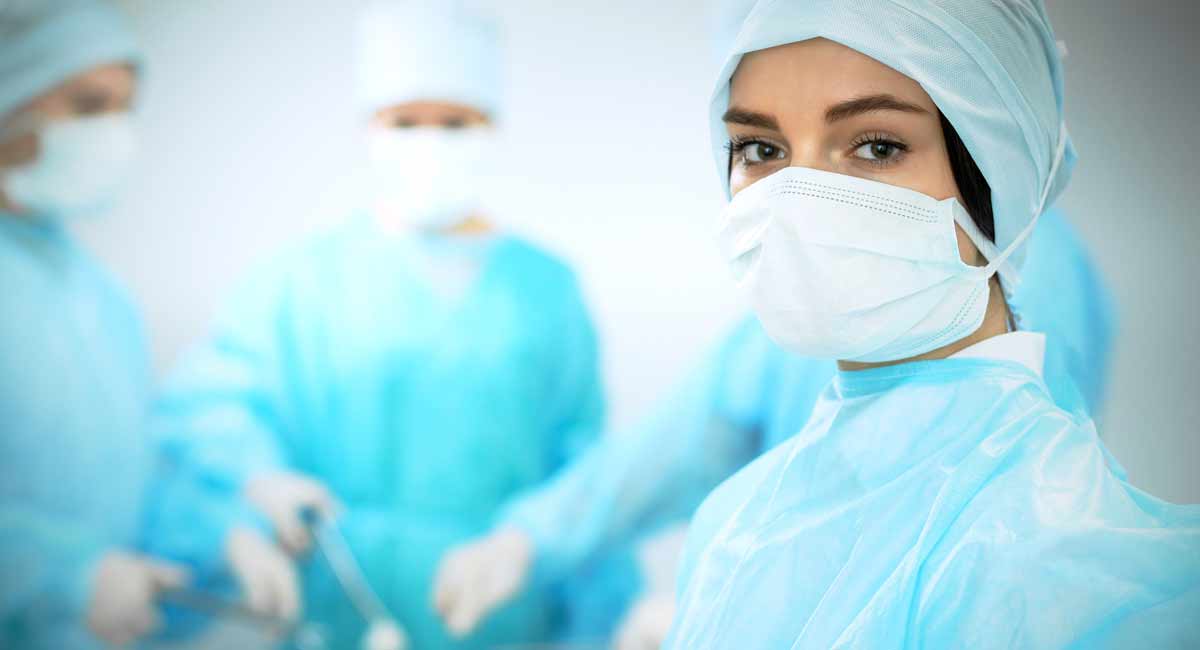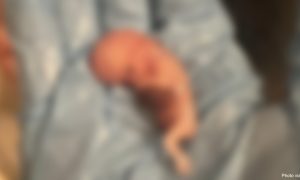An abortion training module published by the University of California San Francisco (UCSF) details reasons a woman might select one of two gruesome later abortion procedures, the D&E (Dilation and Evacuation) dismemberment abortion method and the Induction abortion method. UCSF trains abortion providers and also provides later abortions at its Women’s Option Center.
WARNING: Abortion victim images are below and may be disturbing.
The information is presented in a lecture by Jennifer Kerns, an assistant professor at UCSF, who states in her presentation, “There are approximately 140,000 second trimester abortions that occur every year in the United States.” She adds that “This is an estimation as data collection in the United States isn’t perfect.”
While Kerns focuses on fetal anomalies, she confirms what Live Action News has reported about the non-medical reasons women choose abortions after the first trimester — including financial, lack of partner, interfering with education/career and simply not wanting any more children.
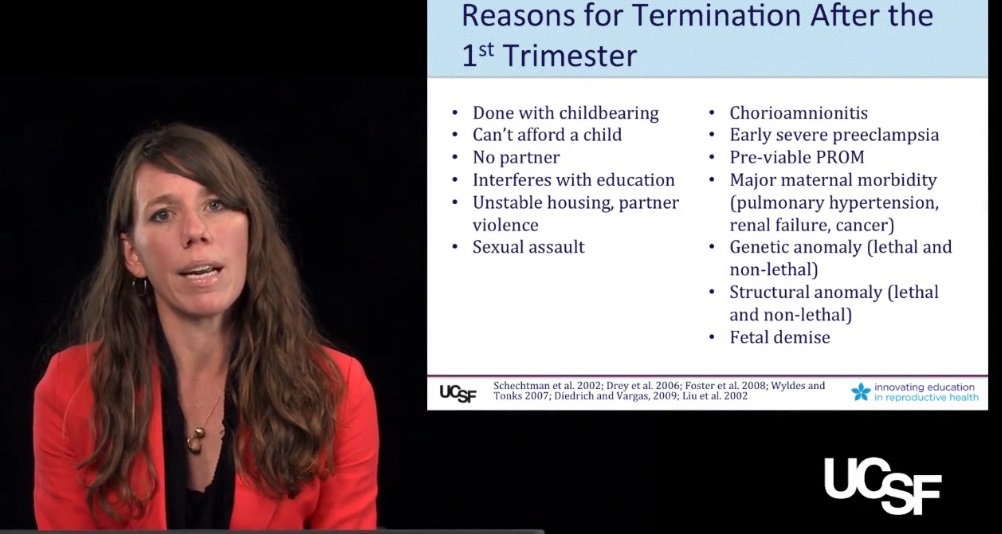
Jennifer Kerns at UCSF reasons abortions after first trimester
Induction abortion is not as common as D&E, which accounts for 96% of second trimester abortions in the US, and requires specialized training, according to Kerns.
She adds that induction procedures also generally costs thousands more than D&E abortions ($3000-$9000 for induction vs. $1000 to $5000 for D&E).
An induction abortion procedure is described by former abortionist Dr. Anthony Levatino in the video below:
Kearns points out that instead of sedation, which is commonly used during D&E procedures, the induction abortion patient is forced to labor throughout the abortion process, and then delivers a dead baby. Women who choose this method of abortion, Kearns notes, typically do so because that want to hold or see the intact baby after the procedure.
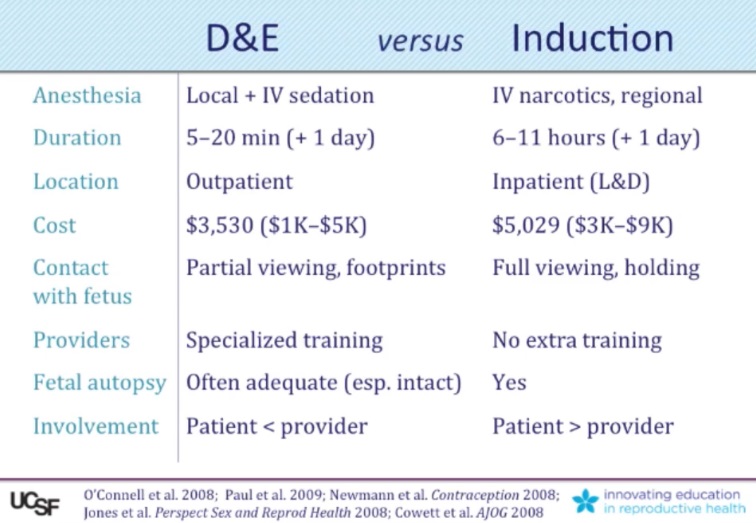
Jennifer Kerns at UCSF differences of D+E and Induction abortion
Kerns states in her presentation that, despite having limited data, patients who choose D&E abortions over the induction method tend to be older and of the “White race,” and are generally women with fetal demise. Reasons for choosing D&E abortions collected from a number of women in a series of qualitative studies, included the fact that they:
- Could not imagine going through birth and knowing their baby was not going to be alive.
- Believed D&E was faster and more impersonal.
- Did not want to go through a live birth.
- Did not want to see the baby because it would have been too difficult.
Kearns went on to note, “There is certainly a greater emotional burden on the provider for doing a D&E than doing an induction.”
READ: Abortionists describe impact of learning D&E abortions
A study on the effects the D&E abortion had on staffers at a late abortion facility in Colorado confirms this. The report authored by late-term abortionist Warren Hern and entitled, “What about us? Staff reactions to D&E,” detailed the negative effects that witnessing abortions had on his staff.
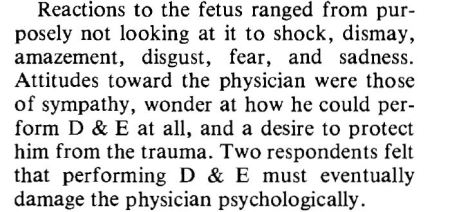
Hern on staff reactions to D&E
The D&E procedure described by former abortionist Anthony Levatino in the video below is a gruesome method of abortion where the abortionist dismembers the preborn baby piece by piece inside the womb.
A report published by the Archives of Pathology, which details pathological fetal tissue inspection from abortion, states that “[A]fter 12 weeks’ clinical gestational age, the fetal tissue becomes larger and the bony tissue is more calcified. Therefore, in the second trimester, D&E is performed because the procedure requires greater cervical dilation and advanced surgical skills for removal of the tissue.”
According to that report, after the abortion, D&E “specimens” are typically “examined in surgical pathology” rather than requiring an autopsy. However, the report notes, it is standard for a pathologist to see or do the following:
- The fetal parts examined externally from head to toe.
- Skull typically collapsed.
- Head circumference is not usually measured.
- Skull bones examined for defects.
- Scalp skin can be identified in most cases.
- Completeness of the face varies from case to case.
- Limbs are examined for bony anomalies and the fingers/toes, nails, and creases are examined on all intact feet and hands.
- Foot length is recorded as a critical anatomic parameter to estimate gestational age.
- The heart is identified in most cases.
- Lung tissue is also found frequently in D&E specimens.
- One or both kidneys are usually found.
- Ureters and bladder are seldom available for adequate assessment.
- The external and/or internal reproductive organs are identified up to 62% of the time, making assessment of gender possible in those cases.
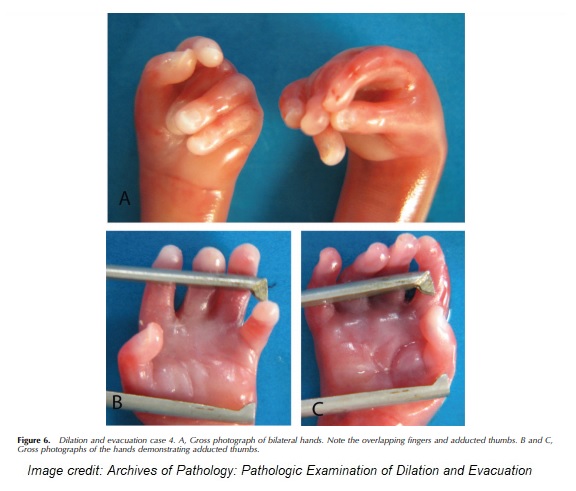
Second trimester D&E abortion specimen fetal hands (Image credit: Archives of Pathology)
According to the authors, “Products of conception, including D&E specimens, are unique among the surgical pathology specimens because the family can request a private cremation or burial for the specimen, which is considered the fetal remains.”
In 2013, Live Action went undercover into several late abortion clinics across America. Video footage taken at an abortion facility operated by abortionist LeRoy Carhart shows the doctor casually describing a combination of a D&E and induction abortion. Carhart tells the Live Action investigator that the abortion will cause the baby (which has no fetal anomalies) to “[get] soft, like mushy, so you push it through,” and saying of the deceased child that it’s “like putting meat in a crock pot.” If the dead child were not delivered completely, Carhart describes removing the baby “in pieces,” using, he jokes, “a pickaxe, a drill bit.”
Editor’s Note: Read previous articles in this series: #1, #2, #3, #4.
“Like” Live Action News on Facebook for more pro-life news and commentary!

